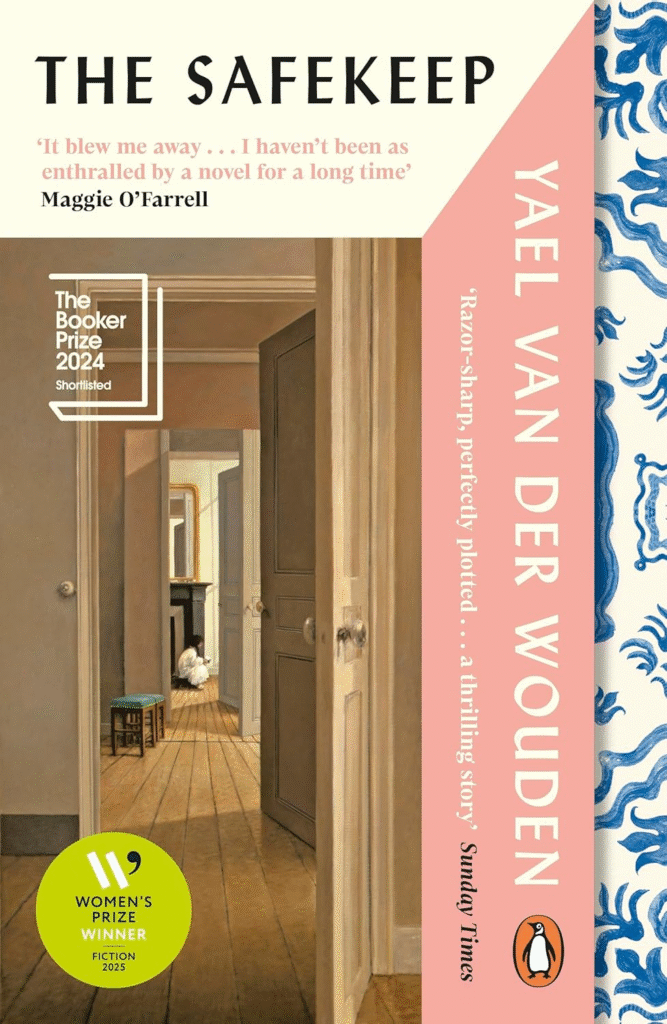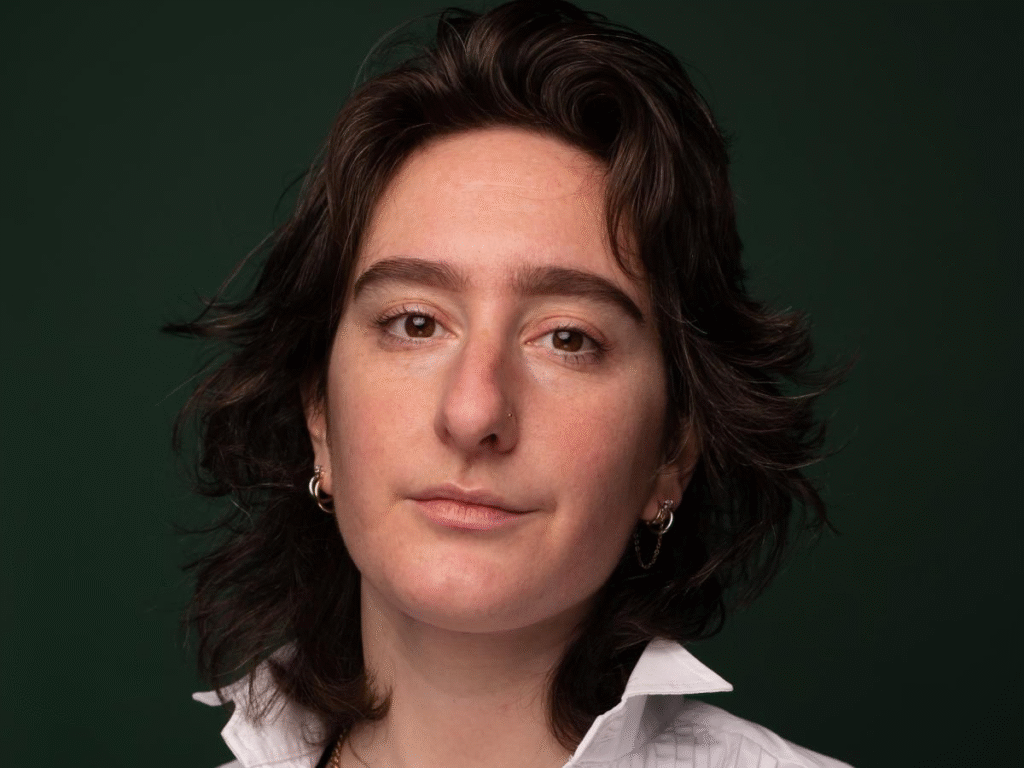The Safekeep by Yael van der Wouden, winner of the Women’s Prize for Fiction 2025, was published in June 2024. This debut novel, set in the Dutch countryside during the summer of 1961, is a chilling story of desire, suspicion, and obsession, exploring the legacy of World War II and the dark truths hidden within a family home. Acclaimed across the literary world, it was also shortlisted for the Booker Prize 2024, shortlisted for the Dylan Thomas Prize 2025, and longlisted for the Wingate Prize 2025.

At the centre of The Safekeep is Isabel (Isa), who lives alone in her late mother’s house in Overijssel. Isa has two brothers; Louis, who brings his girlfriend Eva to stay at the house, and Hendrick, who lives in The Hague with his partner Sebastian. Their uncle Karel originally secured the home during the war, and Isa now occupies it as a caretaker. Isa, stricken by guilt and loneliness, struggles with her maid Neelke, often accusing her of petty theft. As Eva disrupts Isa’s strict routines, suspicion turns into fixation, sparking a dangerous relationship that unravels long-buried family secrets.
The Safekeep is a striking debut that moves from simmering suspicion to obsession as Isabel’s uneasy relationship with Eva exposes the hidden scars of war, the weight of family guilt, and the risks of forbidden desire. The novel captures the charged atmosphere of sibling rivalries, queer love in an era of silence, and the haunting legacy of a house tied to wartime complicity. Both intimate and unsettling, it unfolds as a psychological drama where a seemingly ordinary summer in 1961 becomes a story of passion, betrayal, and long-buried truths, told with precision, emotion, and moral force.
Read Also:Solenoid | Mircea Cărtărescu | Philosophical Novel
About Author: Yael van der Wouden
Yael van der Wouden is a Dutch-Israeli writer and educator, celebrated for her debut novel, The Safekeep. Born in Tel Aviv and raised in the Netherlands, she grew up speaking multiple languages and developed a deep interest in literature and cultural memory. She studied comparative literature at Utrecht University and SUNY Binghamton, focusing on the intersections of history and identity.
The Safekeep quickly gained international recognition, earning a spot on the 2024 Booker Prize shortlist and winning the 2025 Women’s Prize for Fiction. The novel has been praised as a New York Times Notable Book of the Year and featured on best-of-the-year lists by major publications worldwide. Rights for the book have been sold in over a dozen countries, establishing van der Wouden as a rising literary voice.

Known for exploring themes of identity, desire, and historical memory, she continues to write with emotional depth and precision. Currently living in Rotterdam, van der Wouden is working on her second novel, further cementing her reputation as a distinctive and thought-provoking author.
Read Also: The South | Tash Aw | Book Review | Booker Prize 2025
Thematic Analysis: The Safekeep by Yael van der Wouden
In The Safekeep, Isabel (Isa) is outwardly strict and disciplined, a control-obsessed woman who clings to routine and tidiness, yet inside she is conflicted and restless. Her carefully ordered solitude shatters when her brother Louis leaves his outspoken girlfriend Eva at the house for the summer. Her brother Louis, a playboy who moves from one girlfriend to the next, brings Eva to the house and then departs, leaving Isa to host her. In the family’s arrangement, Louis holds the inheritance of the home while Isa is only its caretaker because women have no claim to the property yet she guards it with fierce devotion. Eva, with her bold way of speaking, carefree manner, and striking clothing, unsettles Isa from the start. Their differences create constant friction: Isa resents Eva’s habit of moving freely through the house, touching things, and questioning the family’s past, while Eva chafes against Isa’s cold precision. As household items begin to disappear, suspicion sharpens into obsession, and hostility blurs into longing. What begins as uneasy coexistence transforms into a dangerous intimacy, as Isa and Eva enter a fraught, forbidden sexual relationship. Beneath this bond lies a darker truth that the house itself was taken from Jewish owners during the Second World War forcing Isa to face both her forbidden desires and her family’s complicity in a legacy of guilt and loss.
- Obsession and Forbidden Desire: In The Safekeep, Isa is a woman whose outward discipline masks inner chaos. She is a control freak, meticulously managing her home, yet her internal world is messy and restless. When Eva arrives, Isa’s irritation grows into an intense, forbidden attraction. Eva’s outspoken nature, bold clothing, and uninhibited speech clash with Isa’s rigid order, sparking curiosity and desire. Missing household items only intensify Isa’s obsession, blurring the line between suspicion and longing. Their intimacy is fraught, secretive, and dangerous, showing how repression can fuel desire. Yael van der Wouden illustrates that forbidden passion is never simple or liberating; it exposes vulnerabilities, challenges moral boundaries, and threatens stability. Through Isa and Eva, the novel explores the magnetic pull of obsession, where love, lust, and control collide in a complex, consuming dance that reshapes both women’s lives.
- Sibling Rivalry and Resentment: Family tensions form a critical backdrop in The Safekeep. Isa’s brothers exemplify freedoms she lacks: Louis, a playboy, drifts from one girlfriend to another, leaving Isa to care for the family home he will inherit. Hendrick openly lives with his boyfriend Sebastian, defying societal norms. Isa resents Louis not only for his carefree lifestyle but also for the authority and inheritance he holds over the house she cherishes and maintains meticulously. Her envy and sense of injustice deepen her isolation, reinforcing her obsessive attachment to both Eva and the home. The novel examines how sibling rivalry can magnify insecurities and control, showing that familial love and resentment often coexist. Isa’s struggles underscore the unequal power dynamics within families and highlight how unresolved tension can shape adult behaviour, driving obsession and complicating relationships.
- Objects and Symbolism: In The Safekeep, objects carry emotional and historical significance. A missing spoon, knife, or bowl triggers Isa’s paranoia, reflecting her desperate need for control and perfection. These objects also symbolize the house’s fraught history: a home seized from Jewish owners during the Second World War. Isa’s careful stewardship becomes a psychological anchor, linking identity, memory, and history. Every object holds weight beyond its utility, representing order, inheritance, and moral reckoning. Yael van der Wouden uses these details to show how small items can reflect inner turmoil and historical burdens. By examining the interplay of material objects and human psychology, the novel demonstrates how possessions can embody desire, obsession, and accountability. In this way, everyday items are transformed into narrative devices, illuminating the characters’ emotional states and the legacies they inherit.
- Repression and Female Constraint: Set in 1961 Dutch society, The Safekeep explores the limitations imposed on women. Isa embodies repression, her strict routines and obsessive tidiness acting as armour against her emotions and desires. Her growing attraction to Eva challenges her self-imposed boundaries and exposes the cost of living under societal constraints. Women like Isa were expected to uphold morality, manage domestic spaces, and subordinate personal desires, often silencing themselves in the process. Eva’s presence disrupts Isa’s control, forcing confrontation with the inner chaos repression conceals. The novel underscores how societal rules restrict freedom and personal identity, illustrating that repression breeds both loneliness and vulnerability. Through Isa, van der Wouden portrays the quiet, insidious impact of gendered expectations, revealing the personal and social consequences of a life governed by constraint.
- Family Secrets and Buried Truths: The Safekeep is layered with hidden histories. Isa’s home is not only her sanctuary but a repository of family secrets: her mother’s death, the stolen heritage of the house, and unspoken desires. Eva’s arrival acts as a catalyst, stirring long-suppressed truths to the surface and destabilizing Isa’s fragile sense of order. Secrets in the novel are not mere background; they actively shape character decisions and relationships. Yael van der Wouden emphasizes that families often protect silence more zealously than honesty, leaving younger generations to wrestle with guilt, shame, and unresolved questions. The novel highlights how buried histories, when unearthed, reveal deep emotional, moral, and societal implications. In doing so, it examines how personal and collective pasts intersect, making secrecy both a weapon and a burden in shaping identity and intimacy.
- Loneliness and Isolation: Isa’s life in The Safekeep is dominated by solitude. Her meticulous routines and the careful management of the family home mask profound loneliness. The arrival of Eva disrupts this isolation, igniting intense emotions that Isa has long suppressed. This solitude magnifies Isa’s obsession and fuels her emotional volatility, turning simple interactions into charged confrontations. Van der Wouden shows how isolation can make humans hyper-aware of others, distorting perceptions of connection and intimacy. Loneliness in the novel is both suffocating and formative, illustrating the human need for touch, attention, and understanding. It becomes the soil in which forbidden desire and obsessive behaviors take root, highlighting how prolonged isolation can amplify both vulnerability and emotional intensity, shaping Isa’s actions and responses to the world around her.
- Home as a Living Presence: In The Safekeep, the house is more than a backdrop; it is a character in itself. Its silence, structure, and history exert control over Isa’s life, defining her routines and sense of self. The revelation that the house once belonged to Jewish owners adds layers of guilt and historical burden. Isa’s obsessive care transforms the home into a symbol of stability, identity, and moral responsibility, even as it fosters anxiety and obsession. Eva’s intrusion challenges Isa’s authority, creating a tension between human desire and the weight of inherited history. Van der Wouden demonstrates that a home is never neutral; it embodies the lives, emotions, and choices of those who inhabit it. In this way, the house in the novel mediates personal, familial, and historical narratives, acting as both sanctuary and oppressor.
- Desire and Shame: In The Safekeep, Isa’s desire for Eva is intertwined with guilt and self-reproach. Passion is inseparable from secrecy, as Isa’s attraction violates her strict moral code and societal expectations. The novel portrays shame as both an external judgment and an internalized mechanism of control, shaping Isa’s thoughts and actions. Eva’s uninhibited personality and expressive dress contrast sharply with Isa’s reserved, orderly nature, intensifying feelings of longing and moral conflict. Van der Wouden captures the complexity of desire, showing it as simultaneously liberating and constraining. The interplay of passion and shame drives the narrative tension, illustrating how social norms and personal repression shape intimate relationships. In doing so, the novel examines the psychological depth of attraction in a conservative society, emphasizing that desire is rarely simple and often fraught with consequence.
- Power and Control: Power dynamics underpin much of The Safekeep. Isa maintains control over her environment through meticulous routines and judgmental observation, yet Eva’s arrival disrupts this balance. Their relationship becomes a complex negotiation of dominance, vulnerability, and influence. Isa’s authority over the home, combined with her obsessive tendencies, clashes with Eva’s free-spirited and outspoken nature. This tension demonstrates how attraction can intersect with control, revealing the fluidity of power in intimate relationships. Van der Wouden portrays control as both a defence mechanism and a potential source of harm, showing that desire and authority often entwine in complex ways. The novel highlights the ways humans assert power over spaces, people, and emotions, with the fragile equilibrium of control constantly threatened by external forces or internal impulses.
- The Shadow of War: Though set in 1961, The Safekeep is haunted by the legacy of the Second World War. The house’s history as property seized from Jewish families underscores the lingering effects of displacement, loss, and complicity. Isa inherits both the physical space and the moral ambiguity associated with the past, while Eva’s presence forces confrontation with these historical truths. Van der Wouden illustrates how trauma extends beyond immediate experience, shaping personal behavior and societal structures decades later. The novel emphasizes that history is never truly past; it is embedded in spaces, objects, and memories. By weaving the consequences of war into the narrative, the novelexamines how private lives are inseparable from national and collective histories, and how unacknowledged guilt can inform obsession, desire, and morality.
- Identity and Self-Discovery: Isa’s relationship with Eva in The Safekeep is a journey of self-revelation. Her desire forces confrontation with aspects of herself long suppressed, including curiosity, longing, and emotional vulnerability. The novel portrays identity as fluid and contested, shaped by desire, social norms, and inherited legacies. Eva’s outspoken presence and contrasting lifestyle challenge Isa’s rigid worldview, compelling her to question morality, personal values, and emotional responses. Van der Wouden emphasizes that self-discovery is rarely comfortable; it often emerges through tension, confrontation, and even suffering. Isa’s transformation underscores how intimacy can serve as a mirror, reflecting both hidden strengths and weaknesses, making identity a dynamic interplay of inner reflection, external influence, and emotional awakening.
- Queer Love in Silence: The Safekeep explores the delicate dynamics of queer desire in a time of silence and repression. Isa and Eva’s relationship unfolds clandestinely, existing in private glances, fleeting touches, and secret encounters. The societal norms of 1961 Netherlands make open acknowledgment impossible, heightening both the intensity and the risk of their intimacy. Van der Wouden captures the courage and vulnerability inherent in forbidden love, portraying it as a powerful force that shapes character and narrative. The secrecy surrounding their bond magnifies its emotional weight, illustrating how queer love in a conservative era was both liberating and dangerous. Through Isa and Eva, the novel reveals the ways hidden desire negotiates social constraint, becoming a source of both pleasure and conflict.
- The Fragility of Order: Order is central to Isa’s identity in The Safekeep. Her meticulous routines, careful stewardship of objects, and obsessive attention to detail create a sense of stability. Yet Eva’s arrival, coupled with missing items and the house’s haunting history, rapidly destabilizes this equilibrium. Van der Wouden demonstrates how easily structured lives unravel when confronted with desire, moral ambiguity, or historical truth. The novel portrays order as provisional, built on denial and illusion, and always susceptible to disruption. Isa’s struggle to maintain control reflects the broader human desire to impose stability on an unpredictable world. Through this theme, The Safekeep explores the tension between certainty and chaos, revealing the psychological and emotional consequences when personal structures collapse.
- Class and Social Superiority: Class differences subtly influence interactions in The Safekeep. Isa’s rigid demeanour, polished manners, and obsession with propriety reflect a sense of middle-class superiority. Eva, in contrast, is outspoken, carefree, and unrestrained, her clothing and speech signalling a different social background. Isa’s judgment of Eva reflects both envy and insecurity, revealing the ways class shapes perception, relationships, and desire. The novel examines the subtle hierarchies embedded in social behavior, showing that attraction and conflict are often mediated by unspoken class expectations. Van der Wouden uses Isa’s preoccupations to critique post-war European society’s subtle but enduring class distinctions, illustrating how social hierarchy affects intimacy, morality, and control within personal spaces.
- Inherited Guilt and Historical Memory: The stolen house in The Safekeep embodies historical guilt. Isa inherits not only the physical structure but also a moral burden: it once belonged to Jewish families displaced during the Second World War. Her careful maintenance of the home is intertwined with conscience, duty, and responsibility. Van der Wouden explores how inherited guilt shapes identity, compelling Isa to find the tension between personal attachment and historical awareness. The novel shows that history is alive, carried forward in objects, rituals, and relationships. Isa’s internal reckoning with these truths reflects the broader challenge of confronting past injustices, highlighting how private lives are inseparable from historical legacies. In this way, personal obsession and social conscience are linked, demonstrating that memory is both a privilege and a burden.
- Chaos Within Control: At its core, The Safekeep explores the paradox of control. Isa’s life is outwardly disciplined and every object in place, every routine obeyed but internally, her thoughts, desires, and emotions are turbulent. Eva’s presence exposes this tension, turning Isa’s world upside down. Van der Wouden portrays the fragility of seemingly stable lives, showing how internal chaos can coexist with meticulous order. Isa’s obsession with Eva, attention to the house, and rigid moral standards illustrate the struggle to reconcile external control with inner disorder. The novel suggests that humans are rarely as orderly as appearances indicate and that hidden turbulence often drives decision-making, relationships, and desire. This theme captures the essential tension between discipline and instinct, highlighting the complexity of human psychology in a repressive social context.
Impactful Thoughts from The Safekeep
Read Also: Flesh | David Szalay | Booker Prize 2025 Review
“That’s what happens when people die. They take themselves with them and you never ever find out anything new about them ever.”
This quote highlights how the past and family secrets continue to influence the present. Isa’s life is shaped by what remains unspoken, emphasizing how unresolved history can haunt daily existence and affect personal choices.
“She had held a pear in her hand and she had eaten it skin and all… and the hunger still sat in her like an open maw.”
This metaphor vividly conveys Isa’s intense longing, both emotional and physical. The novel explores how desire for love, connection, or control can consume a person, making longing both irresistible and dangerous.
“She belonged to the house in the sense that she had nothing else, no other life than the house, but the house, by itself, did not belong to her.”
Isa’s connection with her inherited home symbolizes identity, responsibility, and the ties between personal history and physical space. The house is both a refuge and a source of tension, reflecting her obsessive nature.
“How quickly did the belly of despair turn itself over into hope, the give of the skin of overripe fruit.”
This imagery captures the delicate shift from despair to hope in Isa’s emotional journey. Moments of desire and optimism emerge unexpectedly, highlighting the tension between repression and longing throughout the novel.
“If you are mine then I am yours. Do you understand? If I stay, if I’m yours then you must keep me, and I can never—”
This line explores love, possession, and control in intimate relationships. It shows how obsession and desire can create both vulnerability and tension, central to Isa and Eva’s connection.
“It embarrassed her, her own reflection. She had strong ideas of beauty that she did not find in herself… They weren’t nice thoughts.”
Isa’s struggle with self-image and internal expectations emphasizes her vulnerability and emotional complexity. The novel captures the tension between societal ideals, personal desire, and self-perception.
“Isabel had never known loneliness like that, one that arrived without the promise of leaving.”
This quote captures the profound isolation Isa experiences in The Safekeep. It highlights how her solitude is not temporary but an enduring presence, shaping her emotions, actions, and relationships. The line underscores the novel’s exploration of loneliness as both a personal struggle and a force that intensifies desire, obsession, and vulnerability.
“When people pass away, they take their stories with them, leaving us never fully knowing everything about them.”
This quote shows how people leave their secrets and untold stories behind when they die, shaping the lives of those who remain. It reflects The Safekeep’s themes of memory, loss, and the lasting impact of the past.
“What was joy, anyway? What was the worth of happiness that left behind a crater thrice the size of its impact.”
This line shows how fleeting joy is when intertwined with past trauma and the bittersweet nature of happiness, showing how fleeting joy can leave deep, lasting effects. Happiness in the story is complex and often shadowed by loss, regret, or unhealed wounds, reflecting the emotional depth of the characters.
Read Also: Seascraper | Benjamin Wood | Themes & Review
Why You Should Read The Safekeep
The Safekeep by Yael van der Wouden is a captivating debut that blends historical reflection, psychological tension, and complex human relationships into one immersive story. The novel is set in 1961 in the Dutch countryside and follows Isabel, a disciplined and orderly woman, whose life is upended when her brother leaves his girlfriend, Eva, at the family home. What begins as irritation soon turns into a tense, fraught relationship filled with desire, suspicion, and unexpected intimacy.
The book stands out for its exceptional character development. Isabel’s obsession with order and control contrasts sharply with Eva’s outspoken, bold personality, creating a dynamic tension that drives the narrative. Beyond romance, the story delves into themes of home, inheritance, guilt, and the lingering impact of World War II, showing how the past shapes both people and spaces.
Van der Wouden’s writing is lush, precise, and immersive, drawing readers into the house, the characters’ emotions, and the moral complexities of their choices. Ordinary objects, like a broken plate in the garden, carry deep symbolic weight, reflecting the hidden histories and inner struggles of the characters.
Readers will also appreciate the novel’s exploration of desire, identity, and queer relationships, framed in a time when such feelings were rarely acknowledged. Every page balances tension, longing, and moral reckoning, making The Safekeep both emotionally powerful and intellectually engaging. For those who enjoy historical fiction, psychological drama, and rich character-drivenstories, this novel is a must-read. It’s a story that lingers long after the final page, inviting reflection on love, obsession, and the meaning of home.
Final thoughts
The Safekeep by Yael van der Wouden is more than just a story of obsession, desire, and family tension; it is a profound exploration of human vulnerability, the weight of history, and the meaning of home. Through Isabel’s strict control of her household and her fraught interactions with Eva, the novel captures how longing, repression, and secrecy shape our lives in ways both intimate and far-reaching. Van der Wouden’s exquisite prose brings each character and object to life, turning everyday items like a broken plate in the garden into powerful symbols of memory, loss, and hidden truths.
As Isabel reflects, “There was no explanation for the broken piece, for where it had come from and why it had been buried.” This line resonates beyond the narrative, reminding readers how the past, desire, and secrets can shape our present in unexpected ways. The Safekeep is a must-read for those who seek a story that is haunting, emotionally layered, and unforgettable.




